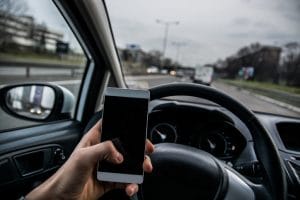A Georgia lawsuit pushes the bounds of products liability litigation: suing an app manufacturer for encouraging unsafe driving.
Most people are aware that you should not be using a smart phone while driving. Many states have specific laws against text, surfing the web or using your phone at all while behind the wheel. And for good reason: distracted driving is far too often the cause of serious, even fatal, accidents.
If a person uses an app or social media while driving, then it seems obvious that they are at fault for any accident that occurs as a result. But what if an app encouraged you to show others how fast you were driving?
Does the Snapchat Encourage Unsafe Driving?
That’s the case with Snapchat, a social media app that allows users to send “snaps” — short videos or pictures that are taken with the app, and then edited to add special effects, filers, captions, drawings and more. These snaps can be sent to others, or saved to a profile as a “story.” The app is particularly popular with younger people — a group that is already notorious for unsafe driving behavior.
One Snapchat filter seems particularly dangerous. Using GPS, the “speed” filter captures data on how fast the user was moving at the time that the picture or video was taken. The speed can then be added to the photo, giving users points or trophies for reaching certain speeds. This was the filter used by one user in Georgia, who allegedly pushed her car to over 100 miles per hour to earn a trophy from Snapchat. A lawsuit filed in Georgia earlier this year alleges that because this driver was distracted by the app and racing to reach a top speed, she struck the plaintiffs’ vehicle at 107 miles an hour and caused serious bodily injury, including permanent brain damage. The plaintiffs are suing both the driver and Snapchat, alleging that Snapchat should have known that its users were utilizing the app — and particularly the speed filter — while driving, but did nothing to remove this dangerous product.
Should an App Be Responsible for How People Use It?
This lawsuit breaks new ground in the products liability world, by attempting to hold the manufacturers of a smartphone app responsible for how people use it. Is the product itself dangerous? Or is the person who used it in an unsafe way the only responsible party?
Ultimately, this case will come down to whether this the makers of this app — which is legal and not defective — should be held liable to third parties who are injured through the use of this app. Snapchat specifically warns against “snapping and driving,” and has terms of service that includes a requirement that “snappers” not use the app in a way that would distract them while driving. These warnings are very clear, but are they effective when there is a specific filter that encourages users to capture their speed and rewards them for hitting certain speeds?
The outcome of this case may close the door on these type of lawsuits, or open up app manufacturers to a world of liability for products that encourage their users to do dangerous things that could harm others.
If you’ve been injured by a dangerous or defective product — including another person’s use of an app in an unsafe way — contact the experienced products liability attorneys at PLBH. We are well-versed in the nuance of products liability law, and stay up-to-date on cases just like the Snapchat lawsuit. We offer free initial consultations, and there is never a fee on products liability case unless we win money for you. Contact us today at (800) 435-7542 or info@plblaw.com to schedule an appointment!

